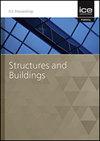Influence of considering substructures on seismic performances of suspen-dome structure
IF 1.4
4区 工程技术
Q3 CONSTRUCTION & BUILDING TECHNOLOGY
Proceedings of the Institution of Civil Engineers-Structures and Buildings
Pub Date : 2022-08-12
DOI:10.1680/jstbu.21.00187
引用次数: 0
Abstract
In order to investigate the influence of substructures on the seismic performance of the suspen-dome structure, taking the suspen-dome roof structure of the Lanzhou Olympic Sports Center Complex as the prototype, a method that replaces complex concrete substructures of the prototype structure with steel substructures in shaking table test was proposed and a scale model considering substructures was established. Firstly, the natural frequencies of the test model were compared with the modal analysis results of the prototype structure considering the scale ratio. After that, an integral numerical model considering substructures was established by ABAQUS, the results of modal analysis and dynamic time history analysis were compared with the test results. Finally, two simplified numerical models with boundary conditions of fixed bearings and three-directional hinged bearings were established. The seismic performances of simplified models and the integral model were compared. It is observed that the method of considering complex concrete substructures of the prototype structure in the shaking table test is accurate and effective. Besides, the numerical model and the modeling method are correct. Moreover, the substructure has a significant impact on the seismic performance of the suspen-dome. The substructure should be considered in the analysis and design stages.考虑子结构对悬架-穹顶结构抗震性能的影响
为了研究子结构对悬架穹顶结构抗震性能的影响,以兰州奥体中心综合体悬架穹顶结构为原型,提出了在振动台试验中将原型结构的复杂混凝土子结构替换为钢子结构的方法,并建立了考虑子结构的比例模型。首先,考虑尺度比,将试验模型的固有频率与原型结构的模态分析结果进行比较;在此基础上,利用ABAQUS建立了考虑子结构的整体数值模型,并将模态分析和动力时程分析结果与试验结果进行了比较。最后,建立了固定轴承和三向铰接轴承边界条件下的简化数值模型。比较了简化模型和积分模型的抗震性能。结果表明,在振动台试验中考虑原型结构复杂混凝土子结构的方法是准确有效的。此外,数值模型和建模方法是正确的。此外,下部结构对悬索穹顶的抗震性能有显著影响。在分析和设计阶段应考虑子结构。
本文章由计算机程序翻译,如有差异,请以英文原文为准。
求助全文
约1分钟内获得全文
求助全文
来源期刊
CiteScore
3.40
自引率
6.20%
发文量
61
审稿时长
12 months
期刊介绍:
Structures and Buildings publishes peer-reviewed papers on the design and construction of civil engineering structures and the applied research associated with such activities. Topics include the design, strength, durability and behaviour of structural components and systems.
Topics covered: energy conservation, people movement within and around buildings, strength and durability of steel and concrete structural components, and the behaviour of building and bridge components and systems

 求助内容:
求助内容: 应助结果提醒方式:
应助结果提醒方式:


